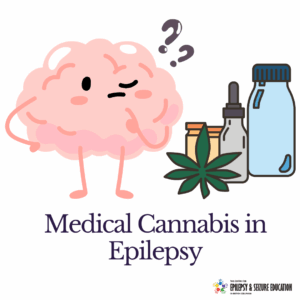Medical Cannabis for Epilepsy

Access, Safety, and Support for Individuals Living with Epilepsy
⚠️ Please note: Medical cannabis is not appropriate for everyone. Always speak with your neurologist or epilepsy specialist before starting treatment.
Introduction
| What is Medical Cannabis? | Who May Benefit? |
|---|---|
| Medical cannabis includes CBD (cannabidiol) and THC (tetrahydrocannabinol) products used to manage health conditions. | – Individuals with drug-resistant epilepsy – Frequent or disabling seizures – Diagnosed syndromes such as Dravet or Lennox-Gastaut |
| CBD-rich oils may help reduce seizure frequency for some people with epilepsy. | – Those who have tried at least two anti-seizure medications without success |
| What It Is | Who It’s For |
|---|---|
| Medical cannabis includes cannabinoids such as CBD (cannabidiol) and THC (tetrahydrocannabinol), used under medical supervision. | Medical cannabis may be an option for people with drug-resistant epilepsy—meaning seizures persist despite trying at least two medications. |
| In epilepsy care, the focus is on CBD-rich oil, which is non-intoxicating and does not produce a “high.” | It may be considered if seizures are frequent, severe, or significantly impact quality of life. |
| CBD oil has the most evidence supporting its use in epilepsy, especially for syndromes like Dravet or Lennox-Gastaut. | It is sometimes used in children but must be monitored closely by a neurologist. |
Access in British Columbia
| Eligibility & Process | How to Access It |
|---|---|
| – Must be 19 years or older and a BC resident – Diagnosis must be confirmed by a neurologist | – Obtain a prescription (medical authorization) – Register with a Health Canada–licensed producer |
| – A prescription is required from a licensed physician or nurse practitioner | – There is no medical cannabis card in BC—access is through a licensed producer after authorization |
Types of Medical Cannabis Products
| Product Type | Description & Relevance to Epilepsy |
|---|---|
| CBD Oil | Most commonly prescribed. High in cannabidiol (CBD), with little or no THC. This oil is non-intoxicating and used orally. |
| CBD:THC Balanced Oil | Contains a low ratio of THC to CBD (e.g., 20:1). Sometimes used cautiously in adults with physician oversight. |
| THC-Dominant Products | Products high in THC are not recommended for epilepsy treatment and may worsen seizures in some individuals. |
| Dried Cannabis Flower | Typically inhaled and not appropriate for epilepsy management. Not prescribed for children or seizure control. |
Research, Evidence & Safety
| What the Research Shows | Risks & Monitoring |
|---|---|
| – About 50% of patients using CBD-rich oil report a 50% or greater reduction in seizure frequency. | – Seizure tracking is essential to determine effectiveness. |
| – Benefits often appear within 3 to 4 months, though longer trials may be needed. | – Bloodwork may be needed to monitor liver enzymes, especially when using other medications like valproate. |
| – Clinical studies use CBD:THC ratios of 12:1 to 50:1, depending on the individual. | – Close supervision is critical to catch potential seizure worsening (~5% of cases) and avoid drug interactions. |
| – Some individuals may not respond or may experience intolerable side effects. | – Interaction with medications such as clobazam can cause excessive sedation and must be adjusted by a doctor. |
Costs in British Columbia
| Product | Typical Cost |
|---|---|
| CBD Oil | ~$0.10–$0.20 per mg of CBD Average monthly cost: $50–$200 |
| Balanced (CBD:THC) Oil | Similar to CBD-only oils, depending on THC content |
| Dried Flower | $5–$15 per gram (not generally recommended for epilepsy) |
| Coverage | Not covered by BC PharmaCare Some private health plans may reimburse in part |
🩺 Treatment Pathway: Step-by-Step
| Stage | Details |
|---|---|
| 1. Consultation | Speak with your neurologist to discuss seizure control and previous medication trials. |
| 2. Assessment | Determine whether cannabis is a safe and appropriate option based on your medical history and current treatment. |
| 3. Prescription | If appropriate, your provider will issue a medical cannabis authorization. |
| 4. Register with Licensed Producer | Choose a Health Canada–approved provider and create an account to order products. |
| 5. Start Low, Go Slow | Begin with a low dose of CBD oil. Dosage is slowly increased under medical guidance. |
| 6. Ongoing Monitoring | Regular follow-ups are required to monitor seizure activity, medication tolerance, and lab results if needed. |
Local Resources & Support
| Helpful Contacts | How ESEBC Can Help |
|---|---|
| – HealthLink BC (8-1-1): Speak with a nurse 24/7 | – Help preparing for doctor appointments – Information on cannabis therapy – Support navigating access |
| – Health Canada: Find licensed producers at canada.ca/cannabis | – Contact us at [email protected] |
Supporting Links
Health Canada – Medical Use of Cannabis
https://www.canada.ca/en/health-canada/services/drugs-medication/cannabis/medical-use.htmlHealth Canada – Licensed Cannabis Producers
https://www.canada.ca/en/health-canada/services/drugs-medication/cannabis/industry-licensees-applicants/authorized-licensed-producers-medical-purposes.htmlCanadian Epilepsy Alliance – Medical Cannabis Position Statement
https://www.epilepsymatters.com/downloads/CEA-Position-on-Medical-Cannabis.pdfCanadian Consortium for the Investigation of Cannabinoids (CCIC)
https://www.ccic.netMedical Cannabis in Pediatric Epilepsy – SickKids Hospital
https://www.youtube.com/watch?v=V6VrN9eYPH0Medical Cannabis and the Developing Brain – UBC Faculty of Medicine Talk
https://www.youtube.com/watch?v=RDflIRo0JdACanadian Medical Association – Cannabis & Patient Care
https://www.cma.ca/cannabis-and-physician-patient-relationshipsHealthLink BC – Cannabis Information
https://www.healthlinkbc.ca/healthy-eating/cannabis
